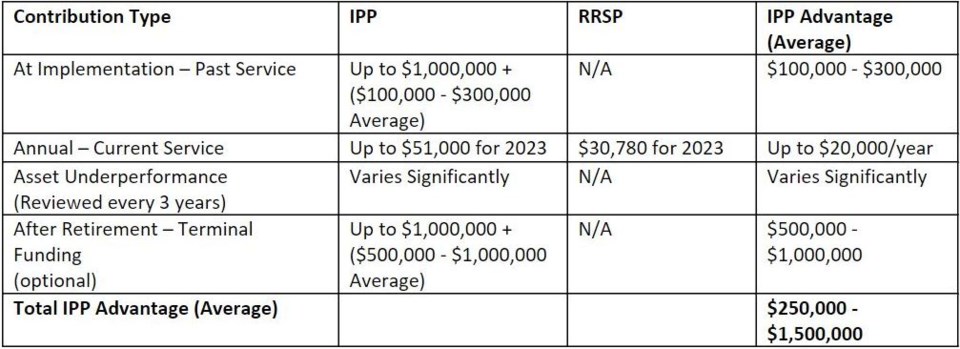Investment and tax professionals have utilized Individual Pension Plans (IPPs) for decades to maximize retirement savings for their clients’ golden years. This type of pension falls under the “defined benefit” vehicle, meaning that this plan will provide a set income when you decide to retire. The pension amount is determined based on the individual’s years of employment, and it is payable for life for every year they are employed after they retire. Contributions are set to sustain the lifetime of the pension.
A potential candidate for the IPP is a business owner or high-earning incorporated professional who is above the age of 40 and wants greater tax-deductible contributions to satisfy their retirement goals. A Registered Retirement Savings Plan (RRSP) has a lower limit of contributions and one of the main appeals of an IPP is that it ages like fine wine. You have a much greater contribution limit as you age. An IPP can invest in securities like stocks, mutual funds, ETFs, GICs very similar to an RRSP, but is exposed to some additional restriction’s due to provincial and federal legislation on pensions.
IPPs becoming more popular
Tax changes in recent years have reduced many tax breaks for business owners. An IPP remains as a great way to help reduce taxable corporate income and to help the plan member save significant amounts for retirement. Additionally, many business owners and incorporated professionals are approaching retirement, and being older can be a big advantage when deciding on whether to set up an IPP.
Eligibility
To ensure that the IPP is the appropriate retirement vehicle for you, here are some requirements you should meet in order to be considered. An IPP member should be 40 years or older if they are a shareholder of the company, however non-shareholders can be younger than 40 to benefit from these types of savings. The pension plan sponsor must originate from an incorporated company that employs the IPP member. The plan sponsor must also pay employment income either on the T4 (box 14) or T4PS (box 35) tax slip. It is important to note that self-employment, partnership, or dividend income is not pension eligible.
Ideally speaking, a strong IPP candidate meets all the minimum requirements, has a long employment history, and sports a high current salary. The older the individual and the higher the level of T4 income, the higher IPP contribution advantage that can be leveraged. If an IPP is established, the individual waives most of their future RRSP contribution room and takes advantage of the higher IPP contribution room available.
Benefits
In most cases, utilizing an IPP will reduce client taxes, therefore allowing the member to gain more on their assets for retirement. This is due to an IPP providing between $250,000 and $1,500,000 in excess deductible contributions when compared to an RRSP. The contributions from the employer are also tax deductible for corporate tax purposes. The contributions are not taxable to the IPP member or employee until it is finally received as pension income.
Maximum IPP Yearly Contributions 2023
*Chart provided by Westcoast Actuaries
As stated above, the contribution room gets larger as the client ages with an IPP. If the client stays within an RRSP, they maintain an annual set maximum limit of $30,780 for 2023 regardless of age within the plan. Whereas with an IPP at age 65 there is a maximum room of $50,700, which is $19,920 higher than a regular RRSP contribution at the same age.
Within the IPP, there are also several lump sum contribution opportunities for the sponsoring corporation. The aggregate funding of an IPP typically comprise the following:
Pension income can be split up to 50 per cent with a spouse for income tax purposes. This can begin after the age of 50 with an IPP, as opposed to age 65 for RRSPs, once converted to a RRIF. Splitting income can be more tax efficient and reduce overall income taxes in some cases. Additionally, IPP assets are also creditor protected.
IPP Contribution Limit Calculation
IPP contributions must be certified by an actuary. This is a requirement for any “defined benefit” pension plan. While RRSP contributions are fixed at 18 percent of earned income each year, IPP contributions are calculated as follows:
Current Service Contributions are the most comparable to RRSPs as they are accrued annually based on the individual’s income, specifically T4 employment income for the IPP. As stated in the diagram below, the current IPP service contribution rate varies by age. For example, the IPP contribution is 20 percent at age 45 and then grows all the way to the maximum limit of 29 percent at age 65.
IPP Maximum Contribution Rate 2023
*Chart provided by Westcoast Actuaries
Past Service Contributions are unlocked after the IPP is approved. It recognizes the IPP members past years of T4 employment income from the sponsoring company. To recognize past service years, the IPP member must transfer an amount from their own personal RRSP to the IPP. The amount is calculated based on the T4 employment income. If the employee lacks the personal RRSP funds necessary to transfer over, it will ultimately reduce past contribution room available to the sponsoring employer.
The transfer amount will depend on the individual’s age and past T4 employment income. The average RRSP transfer requirement for an IPP members past service is between $250,000 and $750,000 and would often generate between $100,000 and $300,000 + of deductible contribution room for the sponsoring company. For older IPP candidates with a long T4 history, the past service contribution room can be as high as $1,000,000 in some cases.
If the IPP member is a controlling shareholder (with 50 percent or more of the shares) or a related person, they may be required to transfer an amount higher than what is summarized above in the table. This is based on the number of years of service to the sponsoring company, age of the individual, and the balance of their personal RRSP and unused RRSP room.
Additional Contributions for Asset Shortfalls affirm that there will be a minimum amount of assets in the IPP. If there are insufficient funds due to underperforming growth of assets in the IPP, then the company is eligible to top up. This is monitored by an actuary and the valuations occur every three years to determine if there are sufficient funds in the pension. The sponsoring company can top up funds during an employee’s tenure and after they are retired.
Enhanced Contributions after Pension Commencement (Terminal Funding) allows a company to make substantial deductible contributions after the IPP member begins to receive pension income. The amount is often between $500,000 to $1,000,000.
IPP at Retirement
When the IPP member decides to retire, in order to activate the IPP they have to decide how they will receive their pension income. Their options are to receive monthly pension from the plan, buy an annuity or transfer the IPP to a life income fund (LIF) or locked in retirement income fund (LRIF). The IPP acts much like an RRSP where you are obligated to receive income from the plan after the age of 71 and when you die the remainder goes to your spouse or estate. Additionally, if you decide to finish your plan early and want to take out cash, it is valuable to seek out tax advice.
Highlights
In most Canadian provinces, a sponsoring company does not have to abide to any contribution requirements. Therefore, it allows the company to have the ability to decide how much contribution room to utilize. An IPP can be underfunded when the sponsoring company does not have enough cash flow, however the unused room carries forward in the years ahead.
Due to recent tax changes, especially in regards to adverse tax consequences of retaining passive investments within a corporation, the IPP becomes more useful for corporation tax reduction.
Setting up an IPP and taking advantage of an employee’s past service can save a corporation thousands of dollars. It can also mitigate the corporation’s exposure to passive investment and allows assets to grow in a tax deferred environment.
Considerations
The IPP member must be prepared to accept restrictions to receive full tax advantages. “Defined benefit” pension plans are locked-in in most provinces, therefore IPP members cannot draw upon assets until commencing their pension from the plan. The pension they will receive is a fixed amount as outlined by the defined benefit plan. Potential IPP candidates need to be aware of these provincial and federal restrictions before committing, as they should not contribute assets to their IPP that they may need to draw upon before retirement.
IPPs can be wound up at any time in most provinces. This is most often done if the plan becomes underfunded, and the sponsoring corporation no longer wants to stay on top of contributions. The IPP can then be transferred to a locked-in RRSP, with most or all the assets being fully transferred over. This is seen as an alternative to paying the pension from the IPP.
Overall, the decision to set up an IPP shouldn’t be done alone. It is important to work with an advisor to determine if utilizing an IPP is a good strategy. An advisor can work with an actuary to choose the best funds for an IPP and set up a plan that fits best for your financial future.
Kevin Greenard CPA CA FMA CFP CIM is a Senior Wealth Advisor and Portfolio Manager, Wealth Management with The Greenard Group at Scotia Wealth Management in Victoria. His column appears every week at timescolonist.com. Call 250-389-2138, email [email protected], or visit .





